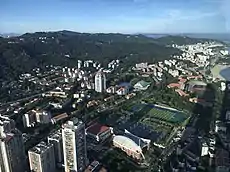Xiamen University
Xiamen University (Chinese: 厦门大学; pinyin: Xiàmén Dàxué) is a national public university located in Xiamen, Fujian, China. It is affiliated with the Ministry of Education of China. The university is part of Project 985, Project 211, and the Double First Class University Plan.
 Seal of the University since 1921 | |||||||||||
| Latin: Universitas Amoiensis | |||||||||||
Former name | Amoy University | ||||||||||
|---|---|---|---|---|---|---|---|---|---|---|---|
| Motto | 自强不息,止于至善[1] Chū-kiông put-sek, chí u chì-siān | ||||||||||
Motto in English | Pursue Excellence, Strive for Perfection[1] | ||||||||||
| Type | Public university | ||||||||||
| Established | 1921 | ||||||||||
| President | Zhang Rong | ||||||||||
Academic staff | 4,600+ | ||||||||||
| Students | 28,133 | ||||||||||
| Undergraduates | 20,277 | ||||||||||
| Postgraduates | 16,562 | ||||||||||
| 4,297 | |||||||||||
| Location | , , China | ||||||||||
| Campus | urban, 524.3 ha | ||||||||||
| Affiliations | Project 985 Project 211 Double First Class University Plan GU8 | ||||||||||
| Website | xmu.edu.cn en.xmu.edu.cn | ||||||||||
| Chinese name | |||||||||||
| Simplified Chinese | 厦门大学 | ||||||||||
| Traditional Chinese | 廈門大學 | ||||||||||
| |||||||||||
Founded in 1921 by Tan Kah Kee, a Chinese patriotic expatriate businessman in Singapore, the university has been perennially regarded as one of the top academic institutions in Southern China, with strengths in mathematics, chemistry, oceanography, economics, management, law, communication and political science.
As of April 2023, over 45,000 students are enrolled at Xiamen University, including more than 21,000 undergraduates, over 19,000 master's students, and above 5,000 doctoral candidates. [2]
Xiamen University is proactive in international exchanges and collaboration. It has forged partnerships with 263 universities abroad and engages in substantial exchanges with 53 globally-renowned institutions. In July 2014, the groundwork for the Xiamen University Malaysia campus was initiated, marking it as the first Chinese university to pioneer an independent campus overseas.[3]
History
Private period

In 1919, Tan Kah Kee, a Chinese expatriate in Singapore, businessman, investor, and philanthropist, donated then 4 million dollars to endow Amoy University in the city of Amoy (former romanization of 'Xiamen' until 1970s). When the university was founded in 1921, there were no more than 20 faculty members and just 98 students.
At the 1926 Sesquicentennial International Exposition in Philadelphia, United States, Amoy University was one of five institutions selected to participate in an exhibit on education in China, representing the country's higher education system.[4]
National university period
In 1937, Tan transferred administration of the university to the Nationalist government, and the institution became a national university.




In 1938, at the outbreak of the Second Sino-Japanese War, the university was temporarily relocated to Changting in western Fujian to escape Japanese invasion of Chinese coastal regions.
In 1946, after the war, the university moved back to Xiamen and resumed normal operations.
In 1952, it was transformed into a comprehensive university embracing both arts and science.
In 1963, it was designated as a key university in China.
In 1995, Xiamen University was selected to participate in the 211 Project, a Chinese government's initiative to provide increased financial resources for the country's most promising universities.[5]
In 2000, the university was selected for the 985 Project, a national and local government initiative to provide funding for facilities construction and faculty hiring to bolster China's top universities.[5]
On January 25, 2013, the Ministry of Higher Education of Malaysia submitted an invitation letter to Xiamen University to establish a branch campus in Malaysia.
On July 3, 2014, the foundation of Xiamen University Malaysia Campus was laid near Kuala Lumpur.
On February 22, 2016, Malaysia Campus officially opened.
In September 2017, the university was recognized as a Class A institution in the Double First Class University Plan, a Chinese government initiative to cultivate a group of elite Chinese universities into "world-class" institutions by 2050.[6]
International cooperation
Xiamen University has maintained a global presence since its creation in 1921, attracting students from overseas Chinese communities in Southeast Asia. The institution established an "Overseas Correspondence Courses" program in 1956 and accepted its first foreign students in 1981.[7] Xiamen University now has an extensive portfolio of international collaborations, including an International Cooperative Program for Innovative Talents funded by the China Scholarship Council, [8] and global exchange and cooperation relationships with over 300 universities.[9] It has established 16 Confucius Institutes with partner institutions in 13 countries.[9]
In 2011, Chinese Premier Wen Jiabao and Malaysian Prime Minister Najib Razak began high-level discussions about creating a Malaysian branch of Xiamen University.[10] Subsequently, in 2015 the Xiamen University Malaysia Campus was established. Known as "XMU Malaysia", the institution has been described as "historic" and is notable as the "first ever large-scale international branch" of a Chinese university.[11] Professor Wang Ruifang was named the first chancellor of XMU Malaysia.[10]
On May 23, 2016, Xiamen University sent a delegation to the Tokyo Institute of Technology in Tokyo, Japan to meet with leadership and professors. The delegation's objective was to discuss the institutions' strategies for commercializing research findings, fostering university-industry collaboration, and encouraging international students to learn about local language and culture.[12]
On November 18, 2016, Xiamen University and Cardiff University in Wales, United Kingdom initiated a "strategic partnership" including a program for co-supervision of doctoral students, and £1.2 million in seed funding for "collaborative research projects" to benefit the economy of Wales.[13] Subsequently, a delegation from Cardiff University visited the Xiamen University School of International Relations to explore possible areas of research collaboration and student exchange.[14]
In October 2018, Xiamen University hosted the 4th Internet+ Innovation and Entrepreneurship Competition.
Xiamen University also hosts recurring China study programs for University of North Carolina at Chapel Hill, Council for Christian Colleges and Universities, Eckerd College[15] and Bentley College in USA, and University College Utrecht in the Netherlands.[16]
Campuses
Main campus (Siming campus)

The main campus of XMU is located in Siming District on Xiamen island, covering an area of 167 hectares. It is situated at the foothills of mountains, facing the ocean and surrounded by Xiamen bay. It mainly houses such academic divisions as the Humanities and Arts, Social Sciences, Natural Sciences, and Engineering and Technology.[17]
The scope and level of its campus high-speed information network is rated first among all universities in China and has become one of the main nodes of CERNET2.
Haiyun campus
The Haiyun Campus is part of the main campus, located near the Pearl Bay, south end of Xiamen, adjacent to Xiamen Software Park. The School of Software, School of Information Science and Technology, School of Mathematics Science are located in the campus.
Zhangzhou campus
Zhangzhou Campus is located in Zhangzhou China Merchants Economic and Technological Development Zone (CMZD), Zhangzhou, covering an area of 171 hectares. It houses XMU Tan Kah Kee College, the Institute of Industrial Technology and other platforms for scientific and technological innovation.[18]
Xiang'an campus
In September 2012, Xiamen University began operations at its Xiang'an Campus, located 34 kilometers from the main campus. The three stated goals of the new campus are to provide facilities for "newly developing disciplines and applied subjects" such as bioscience and energy, to establish "innovation platforms for applied sciences", and to house the southern headquarters of the Confucius Institute.[19]
Currently, the Xiang'an Campus hosts over 10,000 students and faculty from ten schools: the Overseas Education College (which serves international students), the Medical College, the School of Pharmaceutical Sciences, the School of Life Sciences, the School of Public Health, the Nursing Department, the College of Earth Sciences, the College of Environment and Ecology, the School of Energy Research, and the School of Aerospace Engineering.[20]
Malaysia campus (XMUM)
Upon the invitation of the Malaysian Ministry of Higher Education to set up a branch campus in Malaysia, Xiamen University accepted the offer and thus, Xiamen University Malaysia (XMUM) was born in 2015.
In keeping with the vision of our founder Mr. Tan Kah Kee, XMU began in earnest to build our first offshore campus in Malaysia and became the pioneer university from China to establish a branch campus in Malaysia. XMUM aspires to become a university with a distinct global outlook, featuring first-class teaching and research, and embracing cultural diversity.
The campus is located in Bandar Serenia, Sepang, Selangor Darul Ehsan. It is a 10-minute drive from the Kuala Lumpur International Airport, and a 15-minute drive from Putrajaya, the administrative center of the government of Malaysia.[21]
Reputation and rankings
Xiamen University has been consistently regarded as one of the top academic institutions in Southern China, with strengths in economics and management, fine arts, law, chemistry, journalism, communication, mathematics and political science.[22]
Among global university rankings, Xiamen University is ranked =392nd by the 2024 QS World University Rankings,[23] 301-350th by the 2024 world university rankings of the Times Higher Education,[24] 247th by the 2023 U.S. News & World Report Best Global Universities Rankings and 151-200th worldwide by the 2023 Academic Ranking of World Universities.[25]
Faculties and research institutes
As of 1 September 2017, Xiamen University consisted of 20 schools with 44 departments, along with many key research institutes.
- School of Humanities
- School of Foreign Languages and Cultures
- School of Journalism and Communication
- School of Law
- Tan Kah Kee College
- Xiamen Academy of International Law[26][27]
- School of Public Affairs
- School of Economics
- Wang Yanan Institute for Studies in Economics
- School of Management
- College of Art
- College of Chemistry and Chemical Engineering
- School of Physics and Mechanical and Electrical Engineering
- College of Oceanography and Environment
- School of Life Science
- School of Information Science and Technology
- School of Electronic Science &Technology
- School of Mathematics
- Software School
- Medical College
- School of Architecture and Civil Engineering
- Overseas Education College
- Adult Education College
- Professional Technical College
- Internet Education College
- School of Pharmaceutical Sciences
Notable alumni
- Gregory Chow – economist
- Chen Jingrun – mathematician
- Lin Yutang – Chinese writer and inventor
- Yu Guangzhong – Taiwanese writer, poet, educator, and critic
- Xie Xide – president of Fudan University from 1983 to 1989
- Lu Xun – writer
- Raymond Lam – Hong Kong artiste and singer (enrolled for one year, 1996)
- Faye Wong – singer
- Wong Ker-lee – Fujianese Hong Kong businessman and politician
- Zhang Gaoli – CCP Tianjin Committee Secretary and member of Politburo of the Chinese Communist Party
- Li Wo-shi – magistrate of Kinmen County
- Huang Wei – programmer
- Bei Cun - avant-garde Christian novelist.
- Tsai Chih-chan - poet and painter
References
- "Hallmarks". Xiamen University 90th Anniversary Celebration. Xiamen University. Archived from the original on 4 April 2013. Retrieved 14 July 2014.
- "学校简介-厦门大学". www.xmu.edu.cn. Retrieved 20 October 2023.
- "学校简介-厦门大学". www.xmu.edu.cn. Retrieved 20 October 2023.
- "Xiamen University´s Glorious Historical: Participant in 1926 Philadelphia World Expo". ice.xmu.edu.cn. Retrieved 10 February 2018.
- "Best universities in China 2018". 6 September 2017.
- "China to develop 42 world-class universities". People's Daily. 21 September 2017.
- "Xiamen University on the global stage". ice.xmu.edu.cn. Retrieved 10 February 2018.
- "XMU's talent project approved by China Scholarship Council". Xiamen University. 20 January 2018. Retrieved 12 December 2018.
- "Overview". en.xmu.edu.cn. Retrieved 10 February 2018.
- "Xiamen officially opens - Nation | The Star Online". www.thestar.com.my. Retrieved 10 February 2018.
- Bevins, Vincent; Phillips, Tom (7 July 2017). "'Going global': China exports soft power with first large-scale university in Malaysia". the Guardian. Retrieved 10 February 2018.
- "Xiamen University delegation visits Tokyo Tech". Tokyo Institute of Technology (in Japanese). Retrieved 10 February 2018.
- "Cardiff University". Retrieved 10 February 2018.
- "School delegation visits partner university in Xiamen". Cardiff University. Retrieved 10 February 2018.
- "Study Abroad". East Asian Studies | Eckerd College. Retrieved 9 February 2020.
- "Overseas Education College of Xiamen University". oec.xmu.edu.cn. Retrieved 9 February 2020.
- "Siming Campus". en.xmu.edu.cn. Retrieved 21 December 2021.
- "Zhangzhou Campus". en.xmu.edu.cn. Retrieved 21 December 2021.
- "About Xiang'an Campus". liuxue.xmu.edu.cn. Retrieved 10 February 2018.
- WOXnews.com (10 August 2012). "Xiang'an campus of Xiamen University to open in September". Whats on Xiamen, Inc.
- "Malaysia Campus". en.xmu.edu.cn. Retrieved 21 December 2021.
- "Shanghai Ranking-Universities". www.shanghairanking.com. Retrieved 24 September 2021.
- "QS World University Rankings 2024". Top Universities. Retrieved 3 October 2023.
- "World University Rankings". Times Higher Education (THE). 25 September 2023. Retrieved 3 October 2023.
- "ShanghaiRanking's Academic Ranking of World Universities". www.shanghairanking.com. Retrieved 3 October 2023.
- Aizenstatd, Najman Alexander (Fall 2010). "International Law in China: The Xiamen Academy of International Law" (Special China Issue). International Law Quarterly, Florida State Bar: 26. SSRN 1724504.
{{cite journal}}: Cite journal requires|journal=(help) - "Xiamen Academy of International Law". www.xiamenacademy.org.
External links
- Official website (in English)